17 3.4 Carbohydrates
Created by: CK-12/Adapted by Christine Miller
The Cellulose of Our Lives
Created by: CK-12/Adapted by Christine Miller
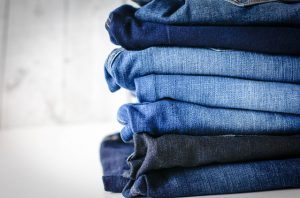
Where would we be without our jeans? They have been the go-to pants for many people for decades, and they are still as popular as ever. Jeans are made of denim, a type of cotton fabric. Cotton is a soft, fluffy fibre that grows in a protective case around the seeds of cotton plants. The fibre is almost pure cellulose. Cellulose is the single most abundant biochemical compound found in Earth’s living things, and it’s one of several types of carbohydrates.
What Are Carbohydrates?
Carbohydrates are the most common class of biochemical compounds. They include sugars and starches. Carbohydrates are used to provide or store energy, among other uses. Like most biochemical compounds, carbohydrates are built of small repeating units, or monomers, which form bonds with each other to make larger molecules, called polymers. In the case of carbohydrates, the small repeating units are known as monosaccharides. Each monosaccharide consists of six carbon atoms, as shown in the model of the monosaccharide glucose shown in Figure 3.4.2.
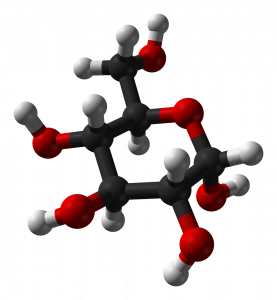
Sugars
Sugars are the general name for sweet, short-chain, soluble carbohydrates, which are found in many foods. Their function in living things is to provide energy. The simplest sugars consist of a single monosaccharide. They include glucose, fructose, and galactose. Glucose is a simple sugar that is used for energy by the cells of living things. Fructose is a simple sugar found in fruits, and galactose is a simple sugar found in milk. Their chemical structures are shown in Figure 3.4.3. All monosaccharides have the formula C6H12O6.
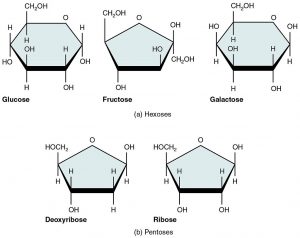
Other sugars contain two monosaccharide molecules and are called disaccharides. These include sucrose (table sugar), maltose, and lactose. Sucrose is composed of one fructose molecule and one glucose molecule, maltose is composed of two glucose molecules, and lactose is composed of one glucose molecule and one galactose molecule. Lactose occurs naturally in milk. Some people are lactose intolerant because they can’t digest lactose. If they drink milk, it causes gas, cramps, and other unpleasant symptoms, unless the milk has been processed to remove the lactose.
Complex Carbohydrates
Some carbohydrates consist of hundreds — or even thousands! — of monosaccharides bonded together in long chains. These carbohydrates are called polysaccharides (“many saccharides”). Polysaccharides are also referred to as complex carbohydrates. Complex carbohydrates that are found in living things include starch, glycogen, cellulose, and chitin. Each type of complex carbohydrate has different functions in living organisms, but they generally either store energy or make up certain structures in living things.
Starch
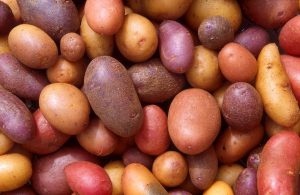
Starch is a complex carbohydrate that is made by plants to store energy. For example, the potatoes pictured in Figure 3.4.4 are packed full of starches that consist mainly of repeating units of glucose and other simple sugars. The leaves of potato plants make sugars by photosynthesis, and the sugars are carried to underground tubers where they are stored as starch. When we eat starchy foods such as potatoes, the starches are broken down by our digestive system into sugars, which provide our cells with energy. Starches are easily and quickly digested with the help of digestive enzymes such as amylase, which is found in the saliva. If you chew a starchy saltine cracker for several minutes, you may start to taste the sugars released as the starch is digested.
Glycogen
Animals do not store energy as starch. Instead, animals store extra energy as the complex carbohydrate glycogen. Glycogen is a polysaccharide of glucose. It serves as a form of energy storage in fungi (as well as animals), and it is the main storage form of glucose in the human body. In humans, glycogen is made and stored primarily in the cells of the liver and muscles. When energy is needed from either storage area, the glycogen is broken down to glucose for use by cells. Muscle glycogen is converted to glucose for use by muscle cells, and liver glycogen is converted to glucose for use throughout the rest of the body. Glycogen forms an energy reserve that can be quickly mobilized to meet a sudden need for glucose, but one that is less compact than the energy reserves of lipids, which are the primary form of energy storage in animals.
Glycogen plays a critical part in the homeostasis of glucose levels in the blood. When blood glucose levels rise too high, excess glucose can be stored in the liver by converting it to glycogen. When glucose levels in the blood fall too low, glycogen in the liver can be broken down to glucose and released into the blood.
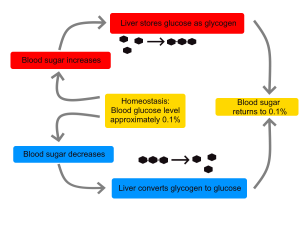
Cellulose
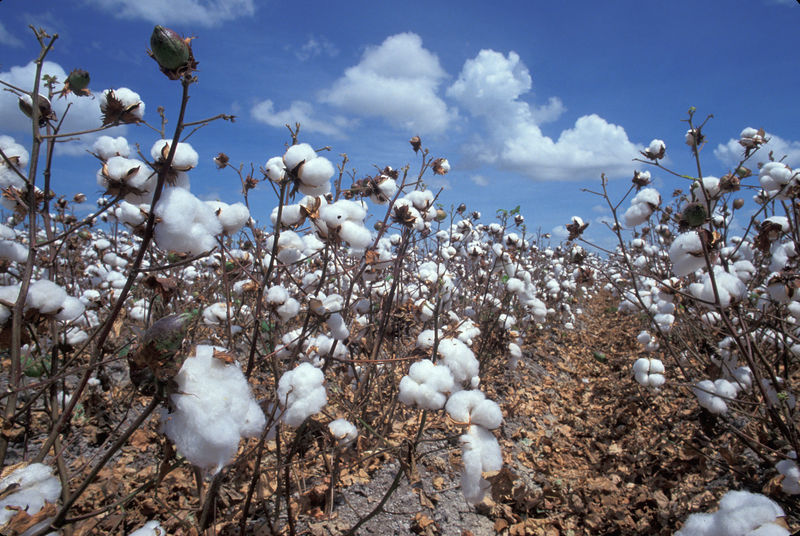
Cellulose is a polysaccharide consisting of a linear chain of several hundred to many thousands of linked glucose units. Cellulose is an important structural component of the cell walls of plants and many algae. Human uses of cellulose include the production of cardboard and paper, which consist mostly of cellulose from wood and cotton. The cotton fibres pictured are about 90 per cent cellulose.
Certain animals, including termites and ruminants such as cows, can digest cellulose with the help of microorganisms that live in their gut. Humans cannot digest cellulose, but it nonetheless plays an important role in our diet. It acts as a water-attracting bulking agent for feces in the digestive tract and is often referred to as “dietary fibre.” In simpler terms, it helps you poop.
Chitin
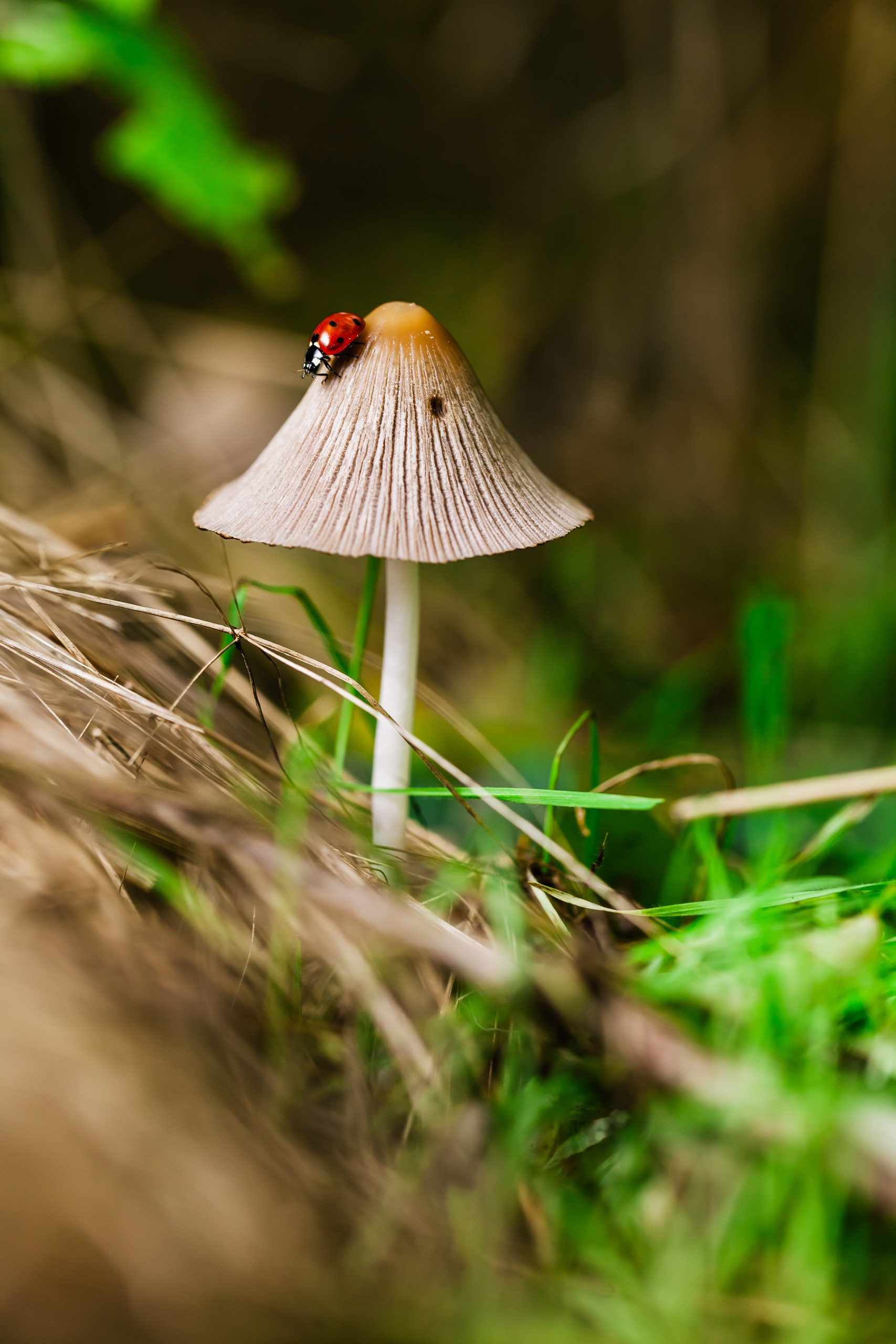
Chitin is a long-chain polymer of a derivative of glucose. It is found in many living things. For example, it is a component of the cell walls of fungi; the exoskeletons of arthropods, such as crustaceans and insects ; and the beaks and internal shells of animals, such as squids and octopuses. The structure of chitin is similar to that of cellulose.
In Figure 3.4.7, both the exoskeleton of the ladybug and the cell walls of the mushroom are made partly of the complex carbohydrate chitin.
The Right Molecule for the Job
Starch, glycogen, cellulose and chitin are all made from the monomer glucose. So how are they all so different? Their difference in structure and function is related to how they are linked together. Starch is linked in long chains with a small amount of branching, glycogen is linked in many branching chains, and chitin and cellulose form long single chains that pack together tightly. Each of these variations of linking the same monomer, glucose, together creates a different way the molecule can be used. As shown in the Figure 3.4.8 diagram, starch and glycogen have many exposed “ends” of their chains. These are areas where a glucose molecule can easily be removed for use as energy, whereas cellulose does not. For this reason, glycogen and starch are well-suited for energy storage in organisms while cellulose is not. Conversely, cellulose packs many monomers together in a sort of mesh that is very strong — this is why it is a great option for building strong cell walls.
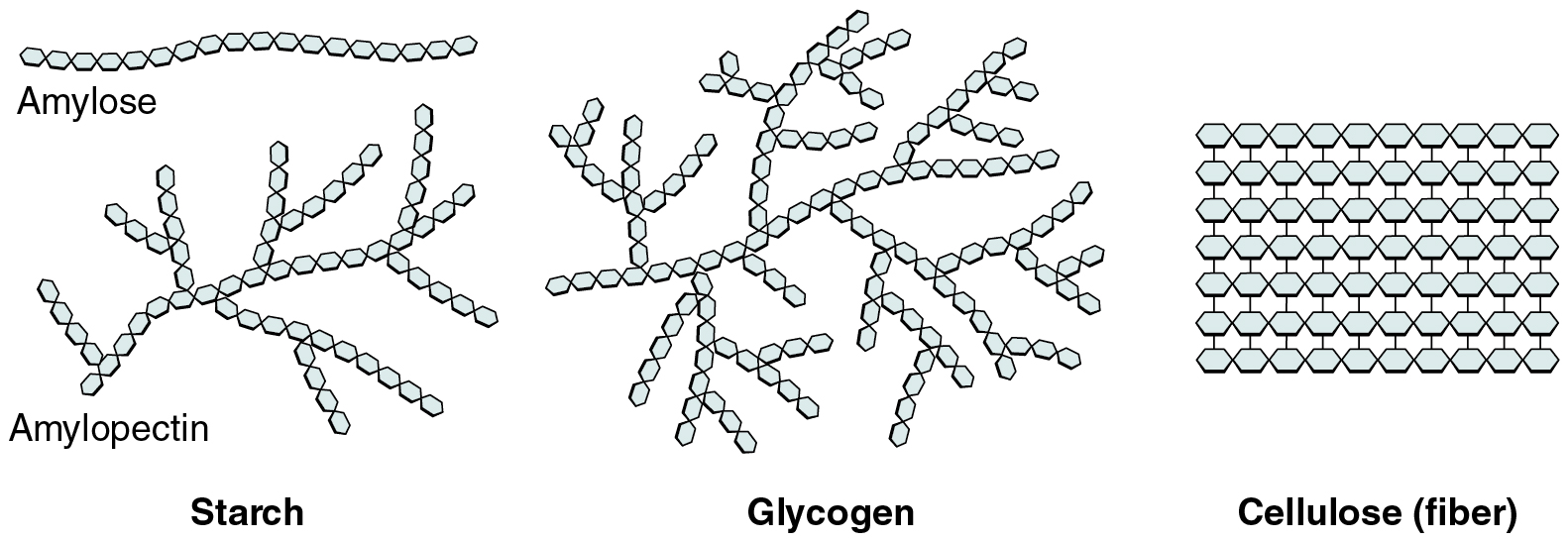
Feature: My Human Biology
You probably know that you should eat plenty of fibre, but do you know how much fibre you need, how fibre contributes to good health, or which foods are good sources of fibre? Dietary fibre consists mainly of cellulose, so it is found primarily in plant-based foods, including fruits, vegetables, whole grains, and legumes. Dietary fibre can’t be broken down and absorbed by your digestive system. Instead, it passes relatively unchanged through your gastrointestinal tract and is excreted in feces (otherwise known as poop). That’s how it helps keep you healthy.
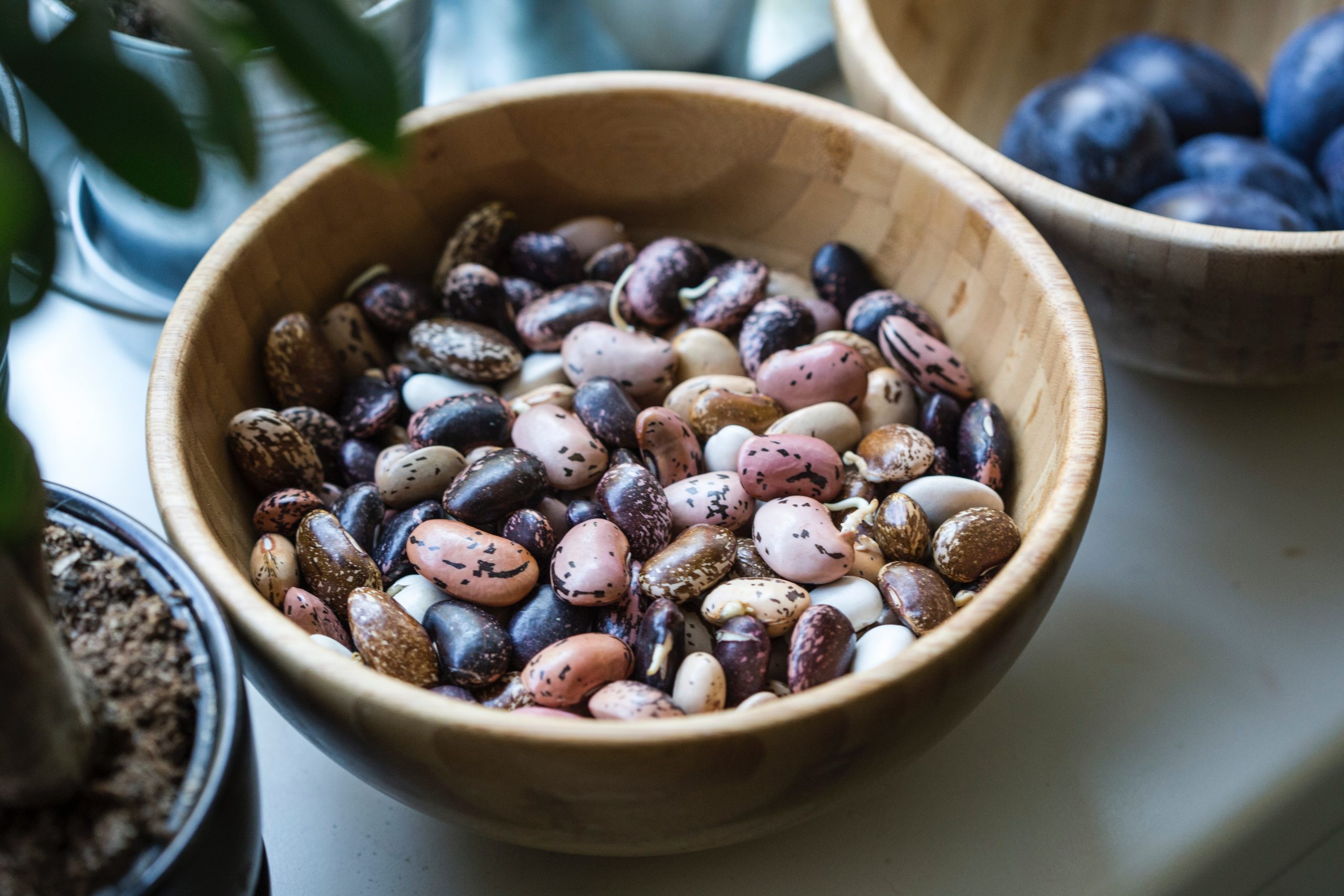
Fibre in food is commonly classified as either soluble or insoluble fibre.
- Soluble fibre dissolves in water to form a gel-like substance as it passes through the gastrointestinal tract. It lowers blood levels of cholesterol and glucose, which is beneficial for your health. Good sources of soluble fibre include whole oats, peas, beans, and apples.
- Insoluble fibre does not dissolve in water. This type of fibre increases the bulk of feces in the large intestine, and helps keep food wastes moving through, which may help prevent or correct constipation. Good sources of insoluble fibre include whole wheat, wheat bran, beans, and potatoes.
How much fibre do you need for good health? That depends on your age and gender. The Institute of Medicine recommends the daily fibre intake for adults shown in Table 3.4.1 below. Most dietitians further recommend a ratio of about three parts of insoluble fibre to one part of soluble fibre each day. Most fibre-rich foods contain both types of fibre, so it usually isn’t necessary to keep track of the two types of fibre as long as your overall fibre intake is adequate.
Table 3.4.1
Recommended Daily Fibre Intake for Males and Females
| Recommended Daily Fibre Intake for Males and Females | ||
| Gender | Age 50 or Younger | Age 51 or Older |
| Male | 38 grams | 30 grams |
| Female | 25 grams | 21 grams |
Use food labels like the one shown below in Figure 3.4.10 and online fibre counters to find out how much total fibre you eat in a typical day. Are you consuming enough fibre for good health? If not, consider ways to increase your intake of this important substance. For example, substitute whole grains for refined grains, eat more legumes (such as beans), and try to consume at least five servings of fruits and vegetables each day.
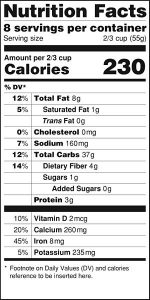
Table 3.4.2
Carbohydrate Comparison
Name |
Class |
Function |
Location |
| Glucose | Monosaccharide | Energy for cells | Cells |
| Starch | Polysaccharide | Energy storage | Plant cells |
| Glycogen | Polysaccharide | Energy storage | Animal cells |
| Cellulose | Polysaccharide | Structural component in cell walls | Plant cells |
| Chitin | Polysaccharide | Structural component in cell walls and exoskeletons | Fungi and arthropods |
3.4 Summary
- Carbohydrates are the most common class of biochemical compounds. The basic building block of carbohydrates is the monosaccharide, which consists of six carbon atoms.
- Sugars are sweet, short-chain, soluble carbohydrates that are found in many foods and supply us with energy. Simple sugars, such as glucose, consist of just one monosaccharide. Some sugars, such as sucrose (or table sugar), consist of two monosaccharides. These are called disaccharides.
- Complex carbohydrates, or polysaccharides, consist of hundreds — or even thousands — of monosaccharides. They include starch, glycogen, cellulose, and chitin. They generally either store energy or form structures, such as cell walls, in living things.
- Starch is a complex carbohydrate that is made by plants to store energy. Potatoes are a good food source of dietary starch, which is readily broken down into its component sugars during digestion.
- Glycogen is a complex carbohydrate that is made by animals and fungi to store energy. Glycogen plays a critical part in the homeostasis of blood glucose levels in humans.
- Cellulose is the single most common biochemical compound in living things. It forms the cell walls of plants and certain algae. Like most other animals, humans cannot digest cellulose, but it makes up most of the crucial dietary fibre in the human diet.
- Chitin is a complex carbohydrate, similar to cellulose, that makes up organic structures, such as the cell walls of fungi and the exoskeletons of insects and other arthropods.
3.4 Review Questions
- What are carbohydrates? Describe their structure.
- Compare and contrast sugars and complex carbohydrates.
-
- If you chew on a starchy food (such as a saltine cracker) for several minutes, it may start to taste sweet. Explain why.
- True or False: Glucose is mainly stored by lipids in the human body.
-
- Name three carbohydrates that contain glucose as a monomer.
- Jeans are made of tough, durable cotton. Based on what you know about the structure of carbohydrates, explain how you think this fabric gets its tough qualities.
- Which do you think is faster to digest — simple sugars or complex carbohydrates? Explain your answer.
- True or False: Cellulose is broken down in the human digestive system into glucose molecules.
- ___________ fibre dissolves in water, __________ fibre does not dissolve in water.
- What are the similarities and differences between muscle glycogen and liver glycogen?
- Which carbohydrate is used directly by the cells of living things for energy?
- Which of the following is not a complex carbohydrate?
- Chitin
- Starch
- Disaccharide
- None of the above
3.4 Explore More
How do carbohydrates impact your health? – Richard J. Wood, TED-Ed, 2016
Why is cotton in everything? – Michael R. Stiff, TED-Ed, 2020
Attributions
Figure 3.4.1
Pile of Jeans by Marco Verch, on Flickr, is used under a CC BY 2.0 (https://creativecommons.org/licenses/by/2.0/) license.
Figure 3.4.2
e-from-xtal-1979-Alpha-D-glucose-from-xtal-1979-3D-balls by Ben Mills [Benjah-bmm27] on Wikimedia Commons, is released into the public domain (https://en.wikipedia.org/wiki/Public_domain).
Figure 3.4.3
Monosasccharides by OpenStax College on Wikimedia Commons is used under a CC BY 4.0 (https://creativecommons.org/licenses/by/4.0) license.
Figure 3.4.4
Potatoes by Jean Beaufort, on Public Domain Pictures.net, is used under a CC0 1.0 Universal Public Domain Dedication license (https://creativecommons.org/publicdomain/zero/1.0/).
Figure 3.4.5
Homeostasis_of_blood_sugar by Christine Miller [christinelmiller] Is used under a CC0 1.0 Universal Public Domain Dedication license (https://creativecommons.org/publicdomain/zero/1.0/).
Figure 3.4.6
Cotton by David Nance for Agricultural Research Service, the research agency of the United States Department of Agriculture, on Wikimedia Commons, is released into the public domain (https://en.wikipedia.org/wiki/Public_domain).
Figure 3.4.7
Ladybug on a mushroom /Fungi in the Woods by Benjamin Balázs on Unsplash is used under the Unsplash License (https://unsplash.com/license).
Figure 3.4.8
Carbohydrate structure comparison [Three Important Polysaccharides] by OpenStax College is on Wikimedia Commons, used under a CC BY 3.0 (https://creativecommons.org/licenses/by/3.0) license.
Figure 3.4.9
Beans by Milada Vigerova on Unsplash is used under the Unsplash License (https://unsplash.com/license).
Figure 3.4.10
FDA Nutrition Facts Label 2014, by US Food and Drug Administration, on Wikimedia Commons is released into the public domain (https://en.wikipedia.org/wiki/Public_domain).
Table 3.4.1
Recommended Daily Fibre Intake for Males and Females is from OpenStax, used under a CC BY 4.0 (https://creativecommons.org/licenses/by/4.0) license..
Table 3.4.2
Carbohydrate Comparison is from OpenStax. used under a CC BY 4.0 (https://creativecommons.org/licenses/by/4.0) license.
References
Betts, J.G., Young, K.A., Wise, J.A., Johnson, E., Poe, B., Kruse, D.H., Korol, O., Johnson, J.E., Womble, M., DeSaix, P. (2013, April 25). Figure 2.18. Five important monosaccharides [image]. In Anatomy and Physiology. OpenStax. https://openstax.org/books/anatomy-and-physiology/pages/1-introduction
Betts, J.G., Young, K.A., Wise, J.A., Johnson, E., Poe, B., Kruse, D.H., Korol, O., Johnson, J.E., Womble, M., DeSaix, P. (2013, April 25). Figure 2.20. Three important polysaccharides [image]. In Anatomy and Physiology. OpenStax. https://openstax.org/books/anatomy-and-physiology/pages/1-introduction
Mayo Clinic. (n.d.). Lactose intolerance [online article]. Mayo Foundation for Medical Education and Research (MFMER). https://www.mayoclinic.org/diseases-conditions/lactose-intolerance/symptoms-causes/syc-20374232
TED-Ed. (2016, January 11). How do carbohydrates impact your health? – Richard J. Wood. YouTube. https://youtu.be/wxzc_2c6GMg
TED-Ed. (2020, January 23). Why is cotton in everything? – Michael R. Stiff. https://www.youtube.com/watch?v=tKLJ6KQAcjI
A biomolecule consisting of carbon (C), hydrogen (H) and oxygen (O) atoms, usually with a hydrogen–oxygen atom ratio of 2:1. Complex carbohydrates are polymers made from monomers of simple carbohydrates, also termed monosaccharides.
The ability to do work.
The simplest form of sugar and the most basic units of carbohydrates, also called simple sugars.
The generic name for sweet-tasting, soluble carbohydrates, many of which are used in food. The various types of sugar are derived from different sources. Simple sugars are called monosaccharides and include glucose, fructose, and galactose.
Glucose (also called dextrose) is a simple sugar with the molecular formula C6H12O6. Glucose is the most abundant monosaccharide, a subcategory of carbohydrates. Glucose is mainly made by plants and most algae during photosynthesis from water and carbon dioxide, using energy from sunlight.
A sugar composed of two linked monosaccharides.
Polysaccharides are carbohydrate molecules composed of long chains of monosaccharide units bound together. They range in structure from linear to highly branched.
A polysaccharide (such as starch, cellulose or chitin) consisting of usually hundreds or thousands of monosaccharide units.
A stored form of glucose used by plants.
Photosynthesis is a process used by plants and other organisms to convert light energy into chemical energy that can later be released to fuel the organisms' activities.
Image shows a diagram of the three types of RNA: Messenger RNA, which is a single strand of RNA, Ribosomal RNA, which is an RNA-protein complex with two subunits, and transfer RNA, which is a single strand of RNA enfolded on itself with an anticodon region and a region which can carry a single amino acid.
Biological molecules that lower amount the energy required for a reaction to occur.
A multi-branched polysaccharide of glucose that serves as a form of energy storage in animals, fungi, and bacteria.
The ability of an organism to maintain constant internal conditions despite external changes.
A substance that makes up most of a plant's cell walls. It is a polymer made up of many linked glucose monomers. Since it is made by all plants, it is probably the most abundant organic compound on Earth.
A long-chain polymer of linked derivatives of glucose. It is an important structural component in the cell walls of fungi, exoskeletons of insects and crustaceans, and in fish scales.
A molecule that can undergo polymerization, creating macromolecules. Large numbers of monomers combine to form polymers in a process called polymerization.

